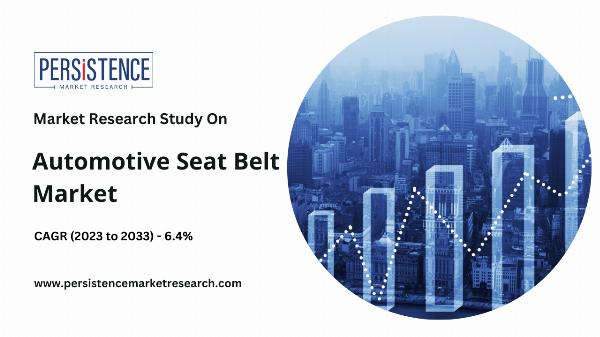Automotive Interiors and Seat Belts: The Importance of Materials and Design

Strong 8k brings an ultra-HD IPTV experience to your living room and your pocket.
Market Overview:
The global Automotive Interior Materials Market is projected to grow significantly, reaching an estimated revenue of US$ 130.06 billion in 2023 and expected to soar to US$ 241.8 billion by 2033, with a compound annual growth rate (CAGR) of 6.4% over the forecast period. This growth is driven by a shifting consumer focus towards comfort and quality, making interior materials a crucial selling point in vehicle purchases. Historically dominated by exterior design, the automotive sector is now undergoing a transformation, integrating advanced technologies and features into vehicle interiors. As consumer preferences evolve, the demand for innovative, high-quality automotive interior materials is set to rise, prompting manufacturers to enhance production processes and offer diverse, personalized options.
In the automotive industry, the integration of safety and comfort is paramount, particularly when it comes to seat belts—one of the most critical components of vehicle interiors. As vehicles evolve with advanced technologies and design philosophies, the importance of materials and design in automotive interiors, specifically concerning seat belts, cannot be overstated. This article delves into the crucial role that materials and design play in enhancing seat belt performance, safety, and overall user experience.
1. The Critical Role of Seat Belts in Automotive Safety
Seat belts are designed to restrain occupants during a collision, preventing ejection and minimizing injuries. Their effectiveness relies heavily on both the materials used in their construction and the design considerations that determine how they function in real-world scenarios. Understanding the intricacies of seat belt materials and design is essential for manufacturers aiming to enhance occupant safety and comfort.
Safety Standards and Regulations
To ensure optimal safety, seat belts must comply with rigorous safety standards set by various regulatory bodies, including the National Highway Traffic Safety Administration (NHTSA) and the European Union. These standards dictate performance metrics, such as tensile strength, durability, and comfort, driving manufacturers to invest in high-quality materials and innovative design strategies.
2. Materials in Seat Belt Manufacturing
The materials used in seat belts are fundamental to their performance. Here are the key materials and their significance:
High-Strength Synthetic Fibers
The primary material used in modern seat belts is high-strength polyester, known for its impressive tensile strength and durability. These synthetic fibers provide the following advantages:
- Durability: High-strength polyester is resistant to wear, UV radiation, and moisture, ensuring longevity even in harsh conditions.
- Lightweight: Being lightweight contributes to overall vehicle efficiency without compromising safety.
Innovative Blends
While polyester dominates the market, manufacturers are increasingly experimenting with blends of materials to optimize performance. For instance:
- Nylon Blends: Nylon is sometimes used in combination with polyester to enhance elasticity and shock absorption, providing added comfort during normal driving conditions while maintaining safety during collisions.
Smart Textiles
The introduction of smart textiles in seat belt manufacturing represents a significant leap forward. These materials may incorporate embedded sensors that monitor the seat belt's condition, alerting users when maintenance or replacement is required. Moreover, smart textiles can adapt to environmental conditions, offering enhanced safety features.
3. Design Considerations for Seat Belts
Design plays a crucial role in the effectiveness and usability of seat belts. Key design considerations include:
Ergonomics
A well-designed seat belt should provide maximum comfort and ease of use for occupants. Ergonomic design involves:
- Adjustable Components: Allowing for adjustments in length and fit ensures that all occupants, regardless of size, can wear the seat belt comfortably and securely.
- Soft Padding: Incorporating soft padding in critical areas enhances comfort, encouraging occupants to wear seat belts consistently.
Aesthetic Integration
As automotive interiors become more sophisticated, the integration of seat belts into the overall aesthetic design of the vehicle is essential. Designers are exploring various color options, patterns, and materials that complement the vehicle's interior while maintaining safety standards.
4. The Impact of Design on Safety Performance
The design of seat belts significantly influences their performance during a collision. Key aspects include:
Tensioning Mechanisms
Advanced tensioning mechanisms, such as pretensioners and load limiters, are designed to optimize seat belt function during an impact. These systems work by:
- Pretensioners: Automatically retracting the seat belt to remove slack when a collision is imminent, ensuring a snug fit.
- Load Limiters: Allowing a controlled amount of give in the belt to reduce forces on the occupant’s chest during a crash, minimizing injury risk.
Connection to Advanced Safety Systems
With the rise of advanced driver-assistance systems (ADAS), the integration of seat belts with these technologies is becoming increasingly important. For example, seat belts may be designed to interact with collision avoidance systems to adjust their tension dynamically based on the vehicle's speed and potential impact.
5. Sustainability in Seat Belt Materials and Design
As environmental concerns continue to rise, the automotive industry is shifting towards sustainable practices in seat belt manufacturing. This includes:
Eco-Friendly Materials
Manufacturers are exploring bio-based materials and recycled fibers for seat belts, aiming to reduce their environmental impact. These materials can offer similar performance characteristics to traditional synthetic options while being more sustainable.
Recycling Initiatives
Implementing recycling programs for seat belts at the end of their lifecycle contributes to a circular economy. Recycled materials can be repurposed for new seat belts or other automotive components, minimizing waste and reducing the need for new raw materials.
6. The Future of Seat Belt Materials and Design
The future of seat belt manufacturing and design is poised for exciting advancements. Key trends to watch include:
Customization Options
As consumer preferences evolve, the demand for personalized automotive interiors is rising. Manufacturers may offer customizable seat belt designs, allowing users to select colors, materials, and styles that suit their tastes while ensuring safety standards are met.
Continued Integration of Technology
The integration of technology in seat belt design will likely expand, with future seat belts incorporating even more advanced sensors and connectivity features. This could enhance safety, allowing real-time data sharing with the vehicle's safety systems to optimize occupant protection.
Conclusion: The Intersection of Materials and Design in Automotive Safety
In the quest for improved occupant safety, the importance of materials and design in seat belts cannot be underestimated. By investing in high-quality materials and innovative design strategies, manufacturers can create seat belts that enhance both safety and comfort. As the automotive industry continues to evolve, the intersection of materials and design will play a critical role in shaping the future of automotive interiors, ensuring that safety remains a top priority for every vehicle on the road.
Note: IndiBlogHub features both user-submitted and editorial content. We do not verify third-party contributions. Read our Disclaimer and Privacy Policyfor details.







